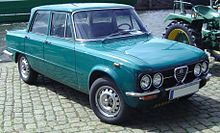Alfa Romeo Giulia
| Alfa Romeo | |
|---|---|
|
Alfa Romeo Giulia (1962–1974)
|
|
| Giulia | |
| Production period: | 1962-1988 |
| Class : | Middle class |
| Body versions : | Sedan , coupe , convertible |
| Engines: |
Otto engines : 1.3-1.6 liter (57-82 kW) diesel engine : 1.8 liters (37 kW) |
| Length: | 4185 mm |
| Width: | 1560 mm |
| Height: | 1430 mm |
| Wheelbase : | 2510 mm |
| Empty weight : | 960-1060 kg |
| Previous model | Alfa Romeo Giulietta |
| successor | Alfa Romeo Giulietta (Type 116) |
The Giulia was a series produced by the Italian car manufacturer Alfa Romeo from mid-1962 to the end of 1978 . The chief designer of Giulia was the engineer Orazio Satta Puliga .
The predecessor was the Giulietta , from which the name - without any diminutive - was adopted. As with the Giulietta, a range of four-door sedan, coupé (Sprint / GT), convertible (Spider and the four-seater GTC) and special models was offered.
limousine
Compared to its predecessor, the limousine, which was launched on June 27, 1962, was no longer called Giulietta Berlina, but just Giulia. Depending on the equipment, the name was supplemented by other additions.
In contrast to the GT “Bertone”, the Berlina and the Spider, the design of the Giulia sedan was an in-house development by Alfa Romeo. You couldn't tell from the somewhat tall and angular shape that it had been tested in the wind tunnel . It had a drag coefficient (c w ) of 0.34, which was low for the time . Designer Orazio Satta Puliga also studied aircraft construction, so he attached great importance to the streamlined aerodynamics of the Giulia sedan. The good aerodynamics of the Giulia sedan was also based on the hatchback principle on the rear roof line and on the trunk lid. The Giulia was also one of the first production vehicles to have a stable safety passenger cell . The small engine (Giulia 1300) developed 78 hp (57 kW) and allowed a top speed of 160 km / h. The top version (TI Super) developed 112 hp (82 kW) and drove a maximum of 190 km / h. Quote from the magazine auto motor und sport : "Superiority that can only be exploited with moderation if you don't want to frighten other road users." The weight-reduced (only 910 kg) Giulia TI Super was produced in 501 copies between 1963 and 1964 and sold exclusively to private racing drivers. It is still the most sought after variant, for which prices of up to 50,000 euros are now being paid.
In mid-1964, the Giulia 1300 appeared with 78 hp (57 kW) and a simpler equipment. In order to use the sporting fame of the ti Super in mass production as well, Alfa Romeo launched the Giulia Super model in 1965, thus creating the high point of the model series, which was to have a decisive influence on the legend of the Giulia. The well-known engine with two overhead camshafts now developed 98 hp (72 kW) thanks to two flat-flow carburettors, good enough for a top speed of 175 km / h. Since it also had significantly increased chrome jewelry and a more elegant interior, it sold excellently from the start.
In 1966 a basic model with 82 hp (60 kW) appeared in the form of the 1300 ti, of which over 144,000 copies were sold by 1972. Due to the success of the Super, and also to avoid confusion with the 1300 ti, Alfa withdrew the original ti from the range in 1967.
A stripped-down 1600 was only available in the Italian market in 1969 as the Giulia 1600 S with 95 hp (70 kW), which, however, was unsuccessful and was discontinued in 1970. In the same year, the small 1300s reached their maximum performance as the Giulia 1300 Super (88 PS / 65 kW) and from April 1972 it was also visually matched to its big sister, so it now also had the double headlight grill and the high-quality interior.
The Giulia limousine (and the station wagon) used to be the official car of the Carabinieri and the police ( Polizia di Stato , Polizia Municipale ) in Italy .
Facelift
To round off the model range at the top, the sedan 1750 Berlina was presented in autumn 1967 , a version of the Giulia that had been smoothed and enlarged by Bertone. She is also often called the "great Giulia". In spring 1971 it was visually and technically revised. The vehicle was now sold as the "2000 Berlina" with an engine enlarged to two liters. Production continued until the end of 1976.
In the summer of 1974 they were replaced by the “Nuova Super”, with extensive model updates . Chassis and performance were improved, in the style of the time it got a dark plastic grille and double headlights of the same size. The "bone back" with the characteristic bead was changed in favor of a smooth trunk lid. The vehicle was better equipped than the BMW 02 series with disc brakes all around, five-speed gearbox, synthetic leather interior, wooden steering wheel and extensive instrumentation .
With a not very lively 50 HP (37 kW) diesel engine from the British Perkins Engines Co., the Nuova Diesel model was added in 1976 , but was only offered in Italy.
At the end of 1978, production ended after 16 years and 572,646 vehicles.
Station wagon
Alfa Romeo itself did not make station wagons. Carrozzeria Colli (Milan), Giorgetti (Montecatini-Terme), Grazia (Bologna), Introzzi (Como), Marazzi (Caronno Pertusella) were among the well-known coachbuilders who built combination structures for Giulia .
The total number of station wagons built from 1962–1978 based on the Giulia 1600 is assumed to be around 800, with Colli and Giorgetti by far the most built. The Alfa works writer Luigi Fusi only incompletely recorded 16 Giulias that were delivered to Colli. The other Giulia station wagons were apparently registered at the factory as normal series Berlinas. Colli and Giorgetti were supplied with new factory vehicles. The station wagons were called Familiare, Giardinetta or Promiscua, but these were not official type designations. The main customers were the Italian police and the Carabinieri. Vehicles with side windows at the rear as well as with a body closed at the sides were produced. The tailgate was available in long and short versions (stop up to the bumper or up to the upper edge of the rear panel). Alfa Romeo Frankfurt a. M. had six Collis (Promiscua) as service vehicles.
Sprint / GT
A coupe on the Giulia floor pan did not appear at the same time as the Giulia Berlina. Instead, the previous Coupé of the Tipo 101 series was initially included in the range. It received the 1.6-liter TI engine of the Giulia, but remained externally unchanged. This transitional model with a Giulietta body and Giulia engine was marketed as the Giulia Sprint (without the name affix GT) from 1962 and remained in this form until 1963.
At the Frankfurt IAA, Alfa Romeo then presented a coupé based on the shortened floor pan of the Giulia Berlina (Tipo 105). The coupe was marketed as the Giulia GT Sprint and was initially only available with the 1.6-liter Bialbero engine. Variants with 1.3, 1.75 and 2.0 liter cubic capacities were added later, which were given additional names such as Veloce or Junior without a uniform structure . They all have a notchback body designed by Giorgio Giugiaro for Bertone , which is described as timeless and harmonious; it is considered to be Giugiaro's early masterpiece. The 2000 GT Veloce with the largest engine has an output of 131 PS (96 kW) and reaches a top speed of 200 km / h.
Gradually, Alfa Romeo added an open version and several competitive versions. The four-seater convertible Giulia Sprint GTC ( Carrozzeria Touring ) is particularly rare with 1000 copies. The Alfa Romeo GTA and GTAm developed by Autodelta were successful in motorsport until the 1970s. The Giulia GT range was produced from 1963 to 1977; During this time almost 225,000 vehicles were built. Its successor was the Alfa Romeo Alfetta GTV .
The Giulia GT was an important car for Alfa Romeo. It offered an extraordinarily attractive design and sporty driving performance at a comparatively low price and thus significantly shaped the myth of the brand. Because of its design, the car is considered a style icon. Many retrospective reports on the Giulia GT play with the image of the affordable dream car for young men. On the other hand, the susceptibility of the bodies to rust was not conducive to the brand's reputation.
Spider
Together with the Giulia limousine, a convertible was also presented in the summer of 1962 under the name "Giulia Spider". It was a facelift of the previous model Giulietta Spider ; both variants were built at Pininfarina . The 1600 machine was identical to the Giulia Sprint and allowed a top speed of 172 km / h, as the Veloce 200 km / h. The external differences to the previous model were minor. The body was lengthened by a few centimeters in favor of the passenger compartment behind the door, an air scoop created space for the larger engine on the bonnet and the side windows, which were previously one-piece, received small triangular windows at the front.
After 10,341 units, the production of the Giulia Spider was completed at the end of 1965. It was succeeded in spring 1966 by the new Spider Duetto .
technology
The gasoline engines offered in the Giulia had 1600 or 1300 cm³. Under the name “Junior”, the coupe was also offered in a slimmed-down version with a 1300 cm³ engine. From spring 1967 there was the new 1750 engine for the Bertone, Berlina and Spider, which was followed by the 2000 engine from summer 1971.
The four-cylinder engines of the Giulia series had a pioneering, sporty and modern design due to Alfa Romeo's motorsport history. The engine was developed based on the Alfa Romeo 1900 by Giuseppe Busso . Engine block and cylinder head are made of aluminum. The crankshaft has five bearings, the pistons run in cylinder liners surrounded by cooling water . A large oil pan with cooling fins cools the oil. As is customary for the brand, all gasoline engines had a cross-flow cylinder head with two chain-driven overhead camshafts ( DOHC ), and the valves were operated directly via bucket tappets . The combustion chambers of the cylinder head were designed hemispherically . Alfa Romeo thus offered the finest racing technology for road vehicles. More powerful variants differed primarily in terms of other carburetor systems up to two double carburettors and higher compression ratios. The sound of the engines had made a significant contribution to the sporty image of the Giulia and the GT. From the spring of 1976, the Giulia Nuova sedan was also offered with a 37 kW diesel engine from Perkins, but with little success.
A fully synchronized five-speed manual transmission was always standard .
The wheels were individually suspended at the front on double wishbones and provided with a worm-roller steering (manufacturer ZF Friedrichshafen ) or with a recirculating ball steering (manufacturer Burman), at the rear there was a rigid axle on two trailing arms and a wishbone . The differential (according to the model with or without ZF multi- disc differential lock ) had an aluminum housing. All wheel suspensions were provided with coil springs and telescopic shock absorbers.
Web links
swell
- ^ Luigi Fusi: Alfa Romeo - Tutte le vetture dal 1910 . Emmeti Grafica Publishing House, Milan 1978.
- ↑ Black and White Garage - 1967 Alfa Romeo Giulia Super Giardinetta by Colli. Retrieved January 29, 2020 (UK English).
- ^ Johnny Tipler: Alfa Romeo Giulia Coupé GT & GTA. Veloce Publishing, 2013, ISBN 978-1-78711-226-1 , p. 23.
- ^ Frank Oleski, Hartmut Lehbrink: Series sports car. Könemann, Cologne 1993, ISBN 3-89508-000-4 , p. 232.
- ↑ Dieter Günther: Permanent sprinter. The Alfa Romeo Giulia Sprint GT and its successors. In: Oldtimer Market. Issue 5/1989, p. 7.
- ↑ Wolfram Nickel: A seductive curve artist. www.zeit.de, December 24, 2013, accessed on July 5, 2019 .
- ^ Eckhard Eybl: Bella Donner. In: Bernd Wieland (ed.): Italian sports car classics. Motorbuch Verlag, 2001, ISBN 3-613-02162-5 .
- ↑ Dieter Günther: Permanent sprinter. The Alfa Romeo Giulia Sprint GT and its successors. In: Oldtimer Market. Issue 5/1989, p. 12.
- ↑ Mike Lawrence: A to Z of Sports Cars, 1945-1990. Bay View Books, 1996, ISBN 1-870979-81-8 , p. 69.
- ↑ Alfa Romeo Giulia ( Memento of September 3, 2011 in the Internet Archive ) (Italian)
| Timeline of Alfa Romeo models from 1945 to today | ||||||||||||||||||||||||||||||||||||||||||||||||||||||||||||||||||||||||||||
|---|---|---|---|---|---|---|---|---|---|---|---|---|---|---|---|---|---|---|---|---|---|---|---|---|---|---|---|---|---|---|---|---|---|---|---|---|---|---|---|---|---|---|---|---|---|---|---|---|---|---|---|---|---|---|---|---|---|---|---|---|---|---|---|---|---|---|---|---|---|---|---|---|---|---|---|---|
| Type | Independent until 1933, then state-owned | from 1986 part of Fiat | ||||||||||||||||||||||||||||||||||||||||||||||||||||||||||||||||||||||||||
| 1940s | 1950s | 1960s | 1970s | 1980s | 1990s | 2000s | 2010s | 2020s | ||||||||||||||||||||||||||||||||||||||||||||||||||||||||||||||||||||
| 5 | 6th | 7th | 8th | 9 | 0 | 1 | 2 | 3 | 4th | 5 | 6th | 7th | 8th | 9 | 0 | 1 | 2 | 3 | 4th | 5 | 6th | 7th | 8th | 9 | 0 | 1 | 2 | 3 | 4th | 5 | 6th | 7th | 8th | 9 | 0 | 1 | 2 | 3 | 4th | 5 | 6th | 7th | 8th | 9 | 0 | 1 | 2 | 3 | 4th | 5 | 6th | 7th | 8th | 9 | 0 | 1 | 2 | 3 | 4th | 5 | 6th | 7th | 8th | 9 | 0 | 1 | 2 | 3 | 4th | 5 | 6th | 7th | 8th | 9 | 0 | |
| Small car | MiTo (955) | |||||||||||||||||||||||||||||||||||||||||||||||||||||||||||||||||||||||||||
| Compact class | Arna | |||||||||||||||||||||||||||||||||||||||||||||||||||||||||||||||||||||||||||
| Alfasud | 33 | 145 , 146 (930) | 147 (937) | Giulietta (940) | ||||||||||||||||||||||||||||||||||||||||||||||||||||||||||||||||||||||||
| Middle class | Giulietta Berlina | Giulia | Giulietta (type 116) | 75 | 155 | 156 (932) | 159 (939) | Giulia (952) | ||||||||||||||||||||||||||||||||||||||||||||||||||||||||||||||||||||
| upper middle class | Alfetta | 90 | 164 | 166 (936) | ||||||||||||||||||||||||||||||||||||||||||||||||||||||||||||||||||||||||
| ... | 6C 2500 | 1900 Berlina | 2000 Berlina | 2600 Berlina | 1750/2000 Berlina | Alfa 6 | ||||||||||||||||||||||||||||||||||||||||||||||||||||||||||||||||||||||
| Coupe | Giulietta Sprint | Giulia Sprint GT | Alfasud Sprint | GT (937) | ||||||||||||||||||||||||||||||||||||||||||||||||||||||||||||||||||||||||
| 1900C sprint / super sprint | 2000 sprint | 2600 sprint | 1750/2000 GT Veloce | Alfetta GT / GTV | GTV (916) | Brera (939) | ||||||||||||||||||||||||||||||||||||||||||||||||||||||||||||||||||||||
| Cabriolet | Giulietta Spider | Giulia Spider | Spider ("Duetto") | Spider (916) | Spider (939) | |||||||||||||||||||||||||||||||||||||||||||||||||||||||||||||||||||||||
| 2000 spider | 2600 spider | |||||||||||||||||||||||||||||||||||||||||||||||||||||||||||||||||||||||||||
| Sports car | Disco Volante | Tipo 33 | Montreal | SZ / RZ | 8C Competizione | 4C | ||||||||||||||||||||||||||||||||||||||||||||||||||||||||||||||||||||||
| Off-road vehicle and SUV | Matta | Stelvio (949) | ||||||||||||||||||||||||||||||||||||||||||||||||||||||||||||||||||||||||||
| Vans | Romeo | F12 / A12 | AR6 | |||||||||||||||||||||||||||||||||||||||||||||||||||||||||||||||||||||||||
| AR8 | ||||||||||||||||||||||||||||||||||||||||||||||||||||||||||||||||||||||||||||
|
|
||||||||||||||||||||||||||||||||||||||||||||||||||||||||||||||||||||||||||||










